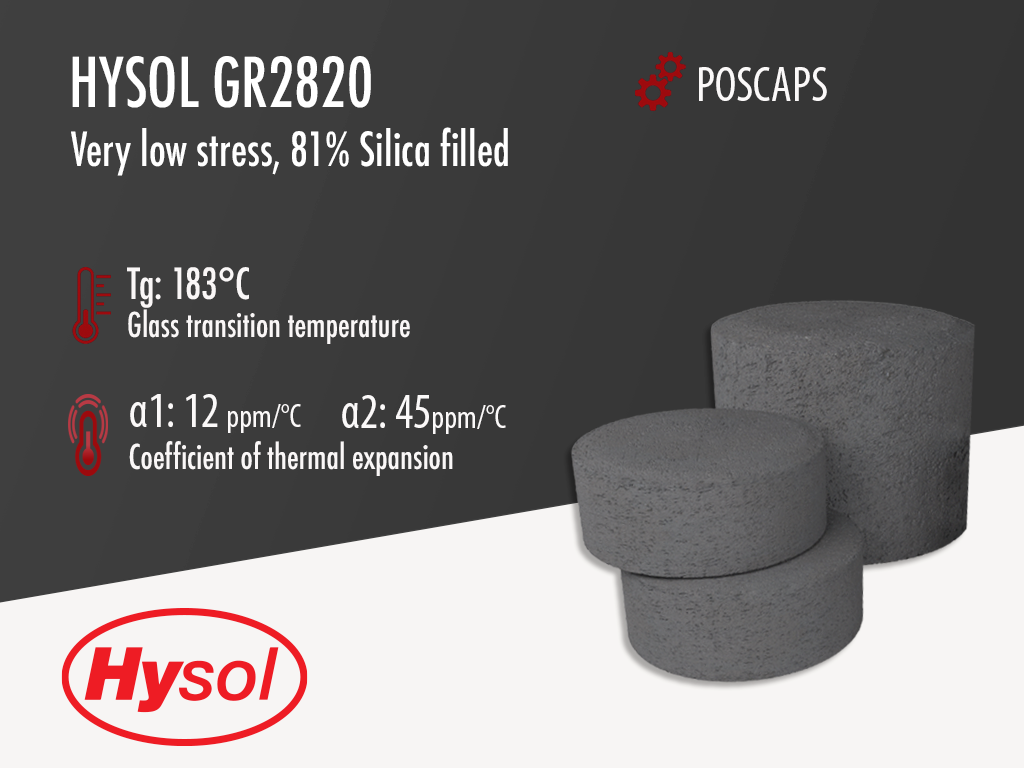Hysol GR2820 | Black Epoxy Mold Compound
- For Conductive Polymer Tantalum Solid Capacitors
- Ultra-low stress
- Thin Wall Crack Resistance
Product Description
Hysol GR2820 is a black, ultra low stress, semiconductor-grade epoxy molding compound designed for the encapsulation and protection of thin walled conductive polymer tantalum solid capacitors (POSCAP). In the world of passive components, POSCAPs are relatively new to the scene. These solid electrolytic capacitors have many advantages, but offer challenges for epoxy mold compound manufacturers. After many years of development, the GR2820 has been developed to have excellent thin wall crack resistance - the greatest challenge of molding these devices. Furthermore, it has been optimized for automolding equipment.
Hysol GR2820 is a silica filled(81%) environmentally "green" halogen free product, meaning it doesn't contain any bromine, antimony or phosphorus flame retardants. Previous MG-series EMC dominated the space for tantalum capacitors but used halogen-containing flame retardants. This material is designed to achieve JEDEC Level 1 requirements at 260°C reflow temperature on conductive polymer capacitors. It's fast cure time also ensures that it is compatible with the latest automold manufacturing equipment. Hysol GR2820 meets UL 94 V-0 Flammability at 1/4 inch (6.35mm) thickness.
Technical Specifications
| General Properties | |||||||||
| Color Color The color | Black | ||||||||
| Filler Content | 83 % | ||||||||
| Specific Gravity Specific Gravity Specific gravity (SG) is the ratio of the density of a substance to the density of a reference substance; equivalently, it is the ratio of the mass of a substance to the mass of a reference substance for the same given volume. For liquids, the reference substance is almost always water (1), while for gases, it is air (1.18) at room temperature. Specific gravity is unitless. | 1.90 | ||||||||
| |||||||||
| Physical Properties | |||||||||
| Spiral Flow @ 175°C | 66 cm | ||||||||
| Chemical Properties | |||||||||
| |||||||||
| Moisture absorption | 0.37 % | ||||||||
| Electrical Properties | |||||||||
| |||||||||
| Volume Resistivity Volume Resistivity Volume resistivity, also called volume resistance, bulk resistance or bulk resistivity is a thickness dependent measurement of the resistivity of a material perpendicular to the plane of the surface. | 1.6x1016 Ohms⋅cm | ||||||||
| Mechanical Properties | |||||||||
| |||||||||
| |||||||||
| Thermal Properties | |||||||||
| |||||||||
| |||||||||
| Glass Transition Temperature (Tg) Glass Transition Temperature (Tg) The glass transition temperature for organic adhesives is a temperature region where the polymers change from glassy and brittle to soft and rubbery. Increasing the temperature further continues the softening process as the viscosity drops too. Temperatures between the glass transition temperature and below the decomposition point of the adhesive are the best region for bonding. The glass-transition temperature Tg of a material characterizes the range of temperatures over which this glass transition occurs. | 183 °C | ||||||||
| UL 94 Rating UL 94 Rating Flammability rating classification. It determines how fast a material burns or extinguishes once it is ignited. HB: slow burning on a horizontal specimen; burning rate less than 76 mm/min for thickness less than 3 mm or burning stops before 100 mm V-2: burning stops within 30 seconds on a vertical specimen; drips of flaming particles are allowed. V-1: burning stops within 30 seconds on a vertical specimen; drips of particles allowed as long as they are not inflamed. V-0: burning stops within 10 seconds on a vertical specimen; drips of particles allowed as long as they are not inflamed. 5VB: burning stops within 60 seconds on a vertical specimen; no drips allowed; plaque specimens may develop a hole. 5VA: burning stops within 60 seconds on a vertical specimen; no drips allowed; plaque specimens may not develop a hole | V0 | ||||||||
| Curing Conditions | |||||||||
| |||||||||
| |||||||||
| Transfer Pressure | 40 - 100 kg/cm2 | ||||||||
| Transfer Time | 6 - 18 s | ||||||||
Additional Information
Applications
Typical applications and uses of Hysol GR2820 | Black Epoxy Mold Compound include:
Technical Datasheets for Hysol GR2820 | Black Epoxy Mold CompoundTDS (English) |
Packaging Details
The following information is specifically related to each unit of measure of Hysol GR2820 | Black Epoxy Mold Compound. If you which to compare this to other product sizes, click on the respective product from the list above and check here for values specific to that product. These values are taken from our internal database and are used in the calculation of the gross weight and packaging dimensions of the goods during shipping. You can use these values to approximate delivery charges using your own carrier. |





